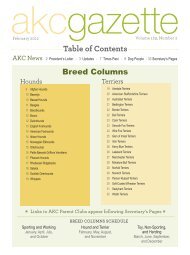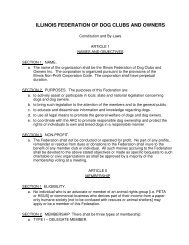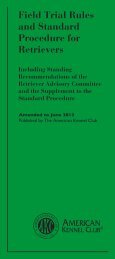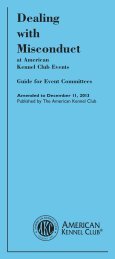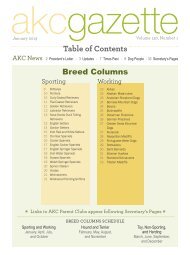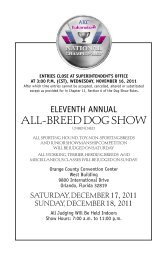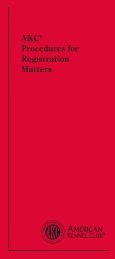Download - Parent Directory - American Kennel Club
Download - Parent Directory - American Kennel Club
Download - Parent Directory - American Kennel Club
- No tags were found...
You also want an ePaper? Increase the reach of your titles
YUMPU automatically turns print PDFs into web optimized ePapers that Google loves.
GZ BREED COLUMNSherdingand new discoveries. Each dog had lessonsto teach and people to introduce.Each subsequent dog further refinedlife with dogs. Owners discover obediencetraining, outlets for their dog’senergy, and like-minded friends whomake wonderful company at dogevents. They become experts on hipscores, genetics, health testing, and thedifferent levels of competition in awide array of activities. They might discoverphotography, writing, and communityservice—all from life with theirdogs.Our dogs have the potential to makeus better people than we knew wewere. If you are looking for a BorderCollie, choose wisely as a way of introducingyourself to a new world.Network and find mentors. If youalready own one (or more), be athoughtful steward for the breed inhonor of the enthusiasts who may follow,absorbing every detail as theyblaze a new path and have new adventures.—Mary Fish Arango,Mary_Arango@cate.org; Border CollieSociety of America website:bordercolliesociety.comBouviers des FlandresAnimals’ Contribution toChild DevelopmentMany of us grew up with animals,if not in the sport. Playing withand caring for our dogs, we could nothave known the social significance ofour activities. Dr. Gail F. Melsondevotes her career to researching thataspect of childhood. She is a professorof developmental studies in theDepartment of Child Developmentand Family Studies at PurdueUniversity. She has co-authored fourbooks and over 50 articles and bookchapters on the significance of animalsto children’s development. Her latestbook is Why the Wild Things Are:Animals in the Lives of Children.Melson’s work is centered on thebiophilia hypothesis. <strong>American</strong> biologistand proponent of sociobiology, EdwardO. Wilson coined the term biophilia todescribe what he believes is humanity’sinnate affinity for the natural world.Melson’s work finds the attachmentto pets to be the basis of nurturance inchildren. This is especially relevant toboys who are not interested in babies.Boys as young as 5 years old will takethe view that “taking care of babies is amommy thing—I am a guy.” The presenceof a pet, however, offers a genderneutraltraining ground for nurturanceand increases empathy and self-esteem.Children naturally incorporate animalsinto their lives with what Melsoncalls “animals of the imagination.”Animals are the most common dreamtheme. They are prevalent in play, especiallyin animal stories. In 19th-centurybooks animals were often used to grabchildren’s attention; for example, toteach the alphabet. Modern use of animalscan be found in advertisingimages, such as in campaigns usingducks, geckos, and bears.Animals play a part in cognitive,social, emotional, and moral development.Rough-and-tumble play as wellas caregiving are valuable in learning toregulate emotions. Pets are always availableand nonjudgmental and have noexpectations. Their friendly presenceinduces relaxation. Melson found thatthe children she studied reported astrong emotional investment in theirpets, saying that they liked their pet asmuch as or more than a good friend.Interaction with pets does notrequire a high level of verbal and socialskills, although it can help improve achild’s decoding of nonverbal communication.Observing a pet’s behaviorand cues can be valuable in helping achild learn to “read” people.A child’s behavioral investment withpets does not decrease as the child getsolder. Social supports such as relationshipwith a pet reduce stress, and ananimal can give the emotional closeness,social integration, reassurance of worth,and an affirmation that one is loved.These benefits continue through life.Melson notes that several universitiesand colleges have programs where studentscan visit with dogs to relievestress and relax. This program evenmerited a reference on the NPR show“Wait, Wait, Don’t Tell Me!” The jokewas that the dog visits were not providingstudents with stress reduction, asexpected—instead, students would procrastinateand then pull “all-nighters”to play with the dog before it had to bereturned. —Jeannette Nieder, airdrie@myfairpoint.net;<strong>American</strong> Bouvierdes Flandres <strong>Club</strong> website: bouvier.orgBriardsDon’t Shoot!—Not Yet,Anyway!You’ve got a winner. Great! Howabout a photo to record thismomentous event? But first, perhaps afew hints are in order to make sure thephoto is the best it can be.As the handler (judges can read thistoo), it’s important to remember that99 percent of the photographer’s attentionis devoted to making your doglook his best. The other one percent istuned to the walkie-talkie calling for aphotographer to Ring Six. You? Well,you’re on your own. You could belooking cross-eyed, and the photographerwill only note that your dog’s leftrear paw needs to be pulled back just atad.Sure, the important thing is that yourBriard looks fabulous—but on theother hand, you don’t want to look likea Frankenstein reject, do you?So before the photographer showsup, give yourself a quick once-over.Hair combed? Make-up refreshed?Buttons buttoned? Zippers zipped?Collar where it’s supposed to be? Nobulging pockets in your jacket? Noripped hems or hanging threads? Mostof all, if you’ve gained a bit of weightor the cleaner shrunk your jacket (ah,that’s it!) and there are gaps betweenbuttons, do yourself a favor and leavethe jacket unbuttoned. Better to lookcasual than in too-tight clothing.Okay, now you’re ready for thephoto. While getting your dog in position,take a second or two to get yourselfinto a flattering pose. Why shouldyour Briard be the only one who looksgood?A K C G A Z E T T E • 33 • S E P T E M B E R 2 0 1 2




